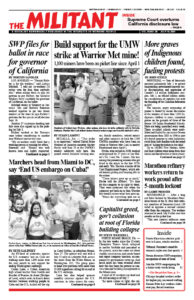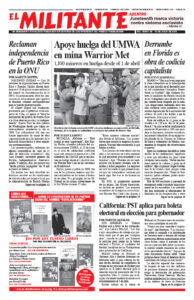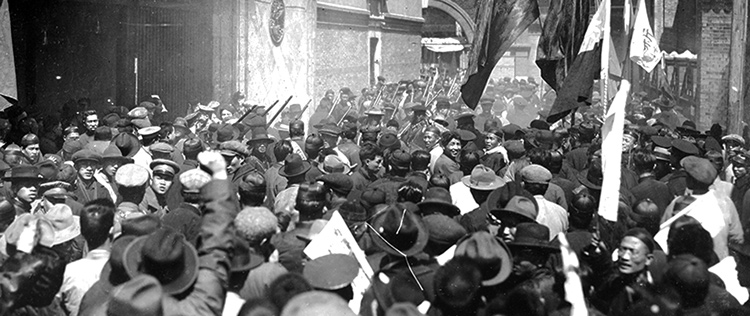Accompanied by well-orchestrated hoopla, Chinese President Xi Jinping and his regime has been putting on a self-serving celebration touting their version of the 100-year anniversary of the country’s ruling Communist Party.
Studying the history of the Chinese Communist Party is valuable for revolutionary-minded workers and youth, but you won’t learn anything truthful from Xi’s extravaganza. Absent in the flurry of rallies and concerts marking the July 1 centenary, was any reference to the party’s transformation — from an organization formed to lead working people to make a socialist revolution — into its opposite. For most of its history the CCP has been communist in name only. Today it serves as a dictatorial machine to defend and advance state capitalist interests against workers and farmers at home and abroad.
Leading up to the celebrations, authorities deleted some 2 million internet posts for failing to correctly echo the party’s version of its history. Officials rewrote their “Short History of the Chinese Communist Party” to eliminate all criticism of previous party leaders.
The new version published this February got rid of anything even slightly critical of former leader Mao Zedong. For instance, Mao’s policies led to famines between 1959 and 1961 in which 30 million people lost their lives. The party’s official history now refers to this catastrophe as “the three-year difficult time.”
All discussion about Mao’s subsequent so-called Cultural Revolution — a bloody purge of his opponents in the party and broader repression aimed at working people — was also eliminated.
Members of Peking University’s Marxist Society got a real taste of the class loyalties of the CCP in 2018. They had studied the writings of Karl Marx, V.I. Lenin and Mao Zedong, as they thought party leaders wanted them to. They decided to put what they read into action, joining workers in Huizhou in southeastern China protesting wretched working conditions and fighting to organize an independent trade union. Authorities had 50 of the young activists arrested.
Origins, counterrevolution in CCP
The CCP was founded by participants in protests against the Japanese occupation of parts of China after the First World War. They were students and workers who wanted to emulate the Bolshevik-led 1917 Russian Revolution. The conquest of power by workers and farmers in Russia gave impetus to revolutionary sentiment across China against the Japanese rulers and the local warlords who aided them.
Armed with the Bolshevik’s revolutionary program, CCP members became deeply involved in student and labor actions and in peasant struggles for land.
A powerful revolutionary upsurge in 1925 opened prospects to advance a fight to establish a workers and farmers government. But over two years that struggle was crushed by the Nationalist Party led by Chiang Kai-shek and the capitalist and landlord classes he represented.
The central reason for the defeat was the course imposed by Joseph Stalin, general secretary of the Communist Party of the Soviet Union, and the bureaucracy he epitomized that was carrying out a counterrevolution against the policies and party of Lenin, the central leader of the Russian Revolution. Stalin and his allies in China insisted a revolution there could only be carried out in a subservient coalition with capitalist forces. That meant putting a brake on strikes, land seizures and other independent action by working people.
Under Stalin’s orders, the majority of CCP leaders forced party members to put down their weapons in areas where the revolution held power and welcome Chiang Kai-shek’s forces as “liberators.” Chiang then organized the massacre of thousands of workers, including CCP members in Shanghai, Canton and elsewhere.
Stalin moved to consolidate his political counterrevolution in the Russian CP, and to back up like-minded allies in the CCP, led by Mao. He refused to allow debate over the disastrous outcome of the 1925-27 Chinese Revolution, and expelled those, like Leon Trotsky, a leader of the Soviet Communist Party who spoke out against Stalin’s betrayal of the revolution.
CCP and the 1949 Revolution
Since the late 1920s, the Stalinized Chinese Communist Party has been an obstacle to advancing a working-class line of march to making a socialist revolution.
After the fall of Japan at the end of the second imperialist world war, the Mao-led CCP faced growing attacks from U.S.-backed forces led by Chiang Kai-shek, and took steps to overthrow him in 1947. Washington had intended to send its armed forces, still based in the Far East, into China to crush Mao and take China as part of its war booty. But U.S. workers in uniform demonstrated by the tens of thousands demanding to go home. When the Mao-led People’s Liberation Army did enter cities to oust Chiang’s forces, it organized to prevent and suppress workers strikes.
As the U.S. rulers moved to crush revolutionary uprisings across the Korean Peninsula, Mao took steps to defend his rule, nationalizing much of China’s industry and its banks. The CCP felt compelled to take steps to end the tyrannical rule of the big landowners and warlords and laid the basis for expropriating the capitalist class in 1949.
The Chinese Revolution freed one-fifth of humanity from imperialism, but the CCP established a dictatorial anti-working-class regime. It remained a Stalinist party. The workers state that came into existence in China was bureaucratically deformed at birth.
China today
After Mao’s death, and a new round of purges, Deng Xiaoping emerged as CCP leader and charted a course to expand capitalist market relations in the 1980s. This led to a rapid expansion of Chinese industry, a huge growth of the working class and mounting conflicts between Beijing and Washington for markets and trade.
Deng, and Xi after him, maintained a dictatorial grip on power. Xi exalts the rule of the Han majority over China, running roughshod over national minorities like the Uyghurs. Union and other mass organizations are tightly controlled as agents of the regime.
The government has systematically crushed political rights in Hong Kong — as it has done for decades in the rest of China, including the slaughter of workers and youth demanding political rights in Tiananmen Square in 1989.
Xi and other CCP leaders fear the example of the protests in Hong Kong could spread among workers and farmers in China.
Working people there are a powerful social force that will make their mark on history. They will have the opportunity to build a party of their own — a party that merits the name communist — in the course of deepening class-struggle experiences and in response to advances in revolutionary struggles elsewhere in the world.
It will be forged in combat against the ruling Chinese “Communist Party” and the exploiting classes it defends.


